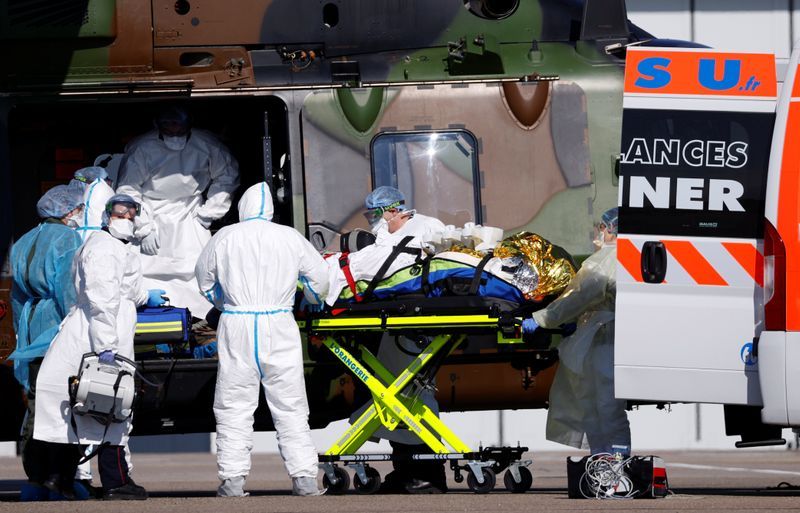 Coronavirus disease (Covid-19) developments in Grand-Est region of France. Reuters
Coronavirus disease (Covid-19) developments in Grand-Est region of France. ReutersThe worldwide death toll from the COVID-19 pandemic passed 100,000 on Friday, and the United States was on the brink of surpassing Italy as the nation with the highest number of fatalities.
The death toll for the coronavirus now stands at 100,376, according to Johns Hopkins University. Italy has seen the most deaths, followed by the US and Spain.
The number of confirmed deaths globally hit 100,375 Friday morning, according to Johns Hopkins University. The true number of lives lost is believed be much higher because of limited testing, different rules for counting the dead and incomplete reporting by some governments.
The economic devastation also continued to rise as the chief of the International Monetary Fund warned that the disease was driving the global economy into what is sure to be the deepest recession since the Great Depression.
The projection by IMF Managing Director Kristalina Georgieva came amid mounting concerns that the virus would soon explode across the world’s poorest nations — where frequent hand washing and social distancing are all but impossible in crowded slums — and inevitably return to countries recovering from outbreaks.-
A handful of European and Asian countries have started easing up on stay-at-home orders, which experts say risks a second wave of coronavirus infections that could prolong the global economic meltdown.
The threat of contagion at Good Friday and Easter observances left public health authorities on edge.

In Kansas, Democratic Gov. Laura Kelly petitioned the state Supreme Court to stop GOP lawmakers from rescinding her ban on religious gatherings. Los Angeles parks, partially open for walking and jogging, will shut down entirely on Sunday to prevent any spread of the virus at traditional Easter outings.
In Italy, helicopters, drones and police patrols were deployed to keep people in their homes over the holiday weekend. Police issued summonses Thursday to 10,000 people traveling for nonessential reasons.
In Paris, the fire-scarred Notre Dame Cathedral, normally packed on Good Friday, was nearly empty as a French archbishop led a televised Good Friday service.
In Jerusalem, the chanting of a small group of clerics inside the Church of the Holy Sepulcher echoed faintly through the heavy wooden doors as a few people stopped and knelt outside to pray. The centuries-old church, built on the site where Christians believe Jesus was crucified, buried and rose from the dead, is usually packed with pilgrims and tourists.
Later, four monks in brown robes and blue surgical masks prayed at the stations of the cross along the Via Dolorosa, the ancient route through the Old City where Jesus is believed to have carried the cross before his execution at the hands of the Romans. It runs past dozens of souvenir shops, cafes and hostels, nearly all of which are closed.
In ordinary times, tens of thousands of pilgrims from around the world retrace Jesus’ steps in the Holy Week leading up to Easter. But this year, flights are grounded and religious sites in the Holy Land are closed as authorities try to prevent the spread of the virus.
More than 1.65 million cases of COVID-19 have been confirmed around the world, but the shortage of testing for the virus means there are without doubt many more left uncounted.
On Friday morning, the U.S. death toll was nearing 17,000, just behind Italy’s 18,279, according to Johns Hopkins University. It was new deaths in the United States that pushed the worldwide death toll above 100,000.
In New York on Friday, Gov. Andrew Cuomo reported 777 new deaths over the last 24 hours. New York’s 7,844 fatalities far exceed any other state’s.
Cuomo called on President Trump to invoke the Defense Production Act to take control of production by private laboratories of tests for virus antibodies, saying widespread testing is the key to reopening the economy.
Without federal money and supervision, he said, the private laboratories developing tests in New York don’t have the capacity to produce enough for the millions of people who need them.
“We need a tremendous, mind-boggling increase in volume quickly,” he said. “And I don’t believe just waiting for the private-sector companies to come up to scale you’re going to see it in the time frame that you need to get it done.”
SOURCE: AGENCIES











